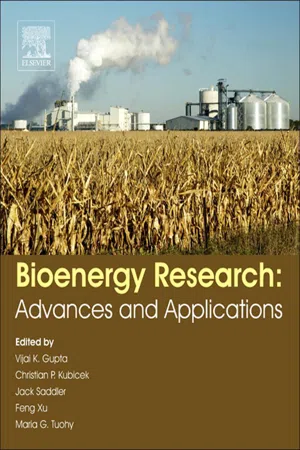
Bioenergy Research: Advances and Applications
- 500 pages
- English
- ePUB (mobile friendly)
- Available on iOS & Android
Bioenergy Research: Advances and Applications
About this book
Bioenergy Research: Advances and Applications brings biology and engineering together to address the challenges of future energy needs. The book consolidates the most recent research on current technologies, concepts, and commercial developments in various types of widely used biofuels and integrated biorefineries, across the disciplines of biochemistry, biotechnology, phytology, and microbiology.All the chapters in the book are derived from international scientific experts in their respective research areas. They provide you with clear and concise information on both standard and more recent bioenergy production methods, including hydrolysis and microbial fermentation. Chapters are also designed to facilitate early stage researchers, and enables you to easily grasp the concepts, methodologies and application of bioenergy technologies. Each chapter in the book describes the merits and drawbacks of each technology as well as its usefulness.The book provides information on recent approaches to graduates, post-graduates, researchers and practitioners studying and working in field of the bioenergy. It is an invaluable information resource on biomass-based biofuels for fundamental and applied research, catering to researchers in the areas of bio-hydrogen, bioethanol, bio-methane and biorefineries, and the use of microbial processes in the conversion of biomass into biofuels.- Reviews all existing and promising technologies for production of advanced biofuels in addition to bioenergy policies and research funding- Cutting-edge research concepts for biofuels production using biological and biochemical routes, including microbial fuel cells- Includes production methods and conversion processes for all types of biofuels, including bioethanol and biohydrogen, and outlines the pros and cons of each
Frequently asked questions
- Essential is ideal for learners and professionals who enjoy exploring a wide range of subjects. Access the Essential Library with 800,000+ trusted titles and best-sellers across business, personal growth, and the humanities. Includes unlimited reading time and Standard Read Aloud voice.
- Complete: Perfect for advanced learners and researchers needing full, unrestricted access. Unlock 1.4M+ books across hundreds of subjects, including academic and specialized titles. The Complete Plan also includes advanced features like Premium Read Aloud and Research Assistant.
Please note we cannot support devices running on iOS 13 and Android 7 or earlier. Learn more about using the app.
Information
Current Bioenergy Researches
Strengths and Future Challenges
Abstract
Keywords
Introduction

Different Forms of Bioenergy
Biopellets

Bioethanol
Table of contents
- Cover image
- Title page
- Table of Contents
- Copyright
- Preface
- Foreword
- List of Contributors
- Chapter 1. Current Bioenergy Researches: Strengths and Future Challenges
- Chapter 2. Bioenergy Research: An Overview on Technological Developments and Bioresources
- Chapter 3. Use of Agroindustrial Residues for Bioethanol Production
- Chapter 4. Recent Advancements in Pretreatment Technologies of Biomass to Produce Bioenergy
- Chapter 5. Biofuels and Bioproducts Produced through Microbial Conversion of Biomass
- Chapter 6. Databases for Bioenergy-Related Enzymes
- Chapter 7. Isobutanol Production from Bioenergy Crops
- Chapter 8. Lipase-Catalyzed Biodiesel Production: Technical Challenges
- Chapter 9. Bioelectrochemistry of Microbial Fuel Cells and their Potential Applications in Bioenergy
- Chapter 10. Second-Generation Biofuel from High-Efficiency Algal-Derived Biocrude
- Chapter 11. Microalgae: The Tiny Microbes with a Big Impact
- Chapter 12. Biobased Fats (Lipids) and Oils from Biomass as a Source of Bioenergy
- Chapter 13. Use of Volatile Solids from Biomass for Energy Production
- Chapter 14. Biorefinery Systems: An Overview
- Chapter 15. Catalytic Thermochemical Processes for Biomass Conversion to Biofuels and Chemicals
- Chapter 16. Applications of Heterogeneous Catalysts in the Production of Biodiesel by Esterification and Transesterification
- Chapter 17. Lignocellulose-Based Chemical Products
- Chapter 18. Industrial Lignins: Analysis, Properties, and Applications
- Chapter 19. Amino-Based Products from Biomass and Microbial Amino Acid Production
- Chapter 20. Production of Phytochemicals, Dyes and Pigments as Coproducts in Bioenergy Processes
- Chapter 21. Recent Developments on Cyanobacteria and Green Algae for Biohydrogen Photoproduction and Its Importance in CO2 Reduction
- Chapter 22. Engineered Cyanobacteria: Research and Application in Bioenergy
- Chapter 23. Sustainable Farming of Bioenergy Crops
- Chapter 24. Bioenergy Technology and Food Industry Waste Valorization for Integrated Production of Polyhydroxyalkanoates
- Chapter 25. Advances and Innovations in Biochar Production and Utilization for Improving Environmental Quality
- Chapter 26. Biochar Processing for Sustainable Development in Current and Future Bioenergy Research
- Chapter 27. Development of Thermochemical and Biochemical Technologies for Biorefineries
- Index